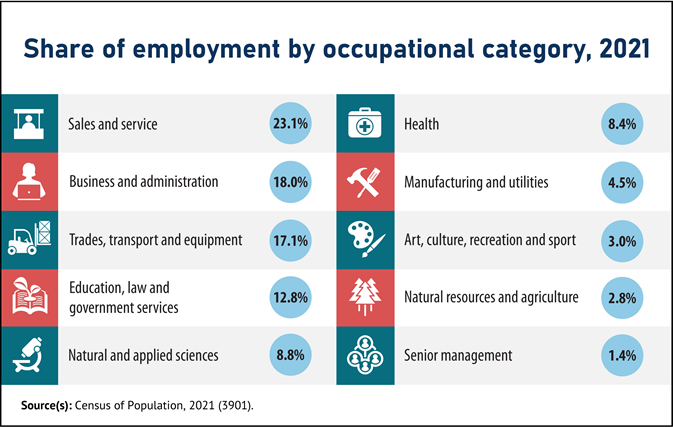There are many different jobs, like working as a pilot for the Canadian Snowbirds, shown here. Each occupation/job will require varying degrees of education, skills or experience. This post provides an overview of the labor and skill shortages in Canada..
In 2022, Canada had unfilled job vacancies occurring across the board which may continue into 2023 and beyond. The aging and mass retiring Boomer generation is thought to underlie this labor crunch. It could prove to be an opportune time for older workers choosing to work past 65. For different motivations, opportunities also exist for Generations X, Y and Z people in this regard.
Labor or Skills shortage or Mismatch?
“When an employer is looking to fill a vacant job, what they are really looking for is a set of skills to complete a series of tasks. So, job vacancies can be thought of as skill-set vacancies, or as unfilled skills demand.
“These three concepts are often used interchangeably, creating confusion and uncertainty, potentially leading to inappropriate or ineffective solutions. As such, the following definitions are recommended:
- Labour shortages refer to a lack of candidates for a specific job in a specific labour market.
- Skills shortages refer to a lack of candidates with the skills required by particular employers.
- Skills mismatches refer to situations in which an employee’s current skills are not well suited to their current job.”
Now that your well versed in skill jargon, time to move onto what shape the Canadian labor market is in.
The infographic below, for 2021 breaks down the labor force by broad occupational categories and the percent employment in each, as reported in the Statistics Canada,Census 2021.

Digging deeper into job growth rates and job vacancies.
- In September 2022, Statistics Canada in their Job vacancies, second quarter 2022 report advises; “Employers across all sectors in Canada were actively seeking to fill nearly one million (997,000) vacant positions in the second quarter, the highest quarterly number on record”.
- From 2016 to 2021, Canadian health care employees increased by 204,000, with a total work force of 1.5 million. The demands of the pandemic, record retirements and an aging population were a large part of this %16.8 increase over 5 years, according to Canada’s 2021 census.
- On top of the %16.8 increase , “there were 136,100 job vacancies in the health care and social assistance sector from the April to June 2022 quarter, up %28 or (+30,500) over last years quarter, with adjustments.”
- The growth in the health-care sector was exceeded by the increase of workers in the professional, scientific and technical services industries, which grew by %17.3 or 219,000 workers over the same 5-year period. Workers in these sectors include software and web developers, auditors, accountants, data scientists and cyber security specialists.
- Of Canada’s 1.5 million health-care workers,%80 are female while workers in the professional, scientific and technical industries are 57% male in this category.
What steps are being taken to address the labor,skill shortage?
Immigration Initiatives
Immigration has and continues to play a large role in meeting labour market demands across Canada, not always making everybody happy though!.
With Boomers retiring and Generation Z and Millennials leaving the service sector in droves, employers in Canada increasingly need to rely on immigration to recruit workers to fill jobs.
In November 2022 the Canadian Minister of Immigration, Refugees and Citizenship, the Honorable Sean Fraser announced a new National Occupational Classification code (NOC) 2021 that creates 16 new occupations to help address acute labour shortages. Those applicants who are admitted under this Express entry program will be eligible for employment and eventual permanent residence. These occupations are:
- payroll administrators
- dental assistants and dental laboratory assistants
- nurse aides, orderlies and patient service associates
- pharmacy technical assistants and pharmacy assistants
- elementary and secondary school teacher assistants
- sheriffs and bailiffs
- correctional service officers
- by-law enforcement and other regulatory officers
- estheticians, electrologists and related occupations
- residential and commercial installers and servicers
- pest controllers and fumigators
- other repairers and servicers
- transport truck drivers
- bus drivers, subway operators and other transit operators
- heavy equipment operators
- aircraft assemblers and aircraft assembly inspectors
“The targets for this program would see; “an increase in the number of immigrants entering include an increase in the number of immigrants entering Canada next year (2023) to 465,000, 485,000 in 2024 and 500,000 in 2025”. This is potentially 1.5 million permanent residents.
The Canadian labor market is in a state of flux, whether it is unfilled job vacancies, skill gaps, record retirement stats, an aging workforce, ambitious immigration programs to ease the labor shortage and Canada’s low fertility rate, skill training initiatives and the digital transformation taking shape!
Exciting times with all the changes and opportunities ahead!
Brian


